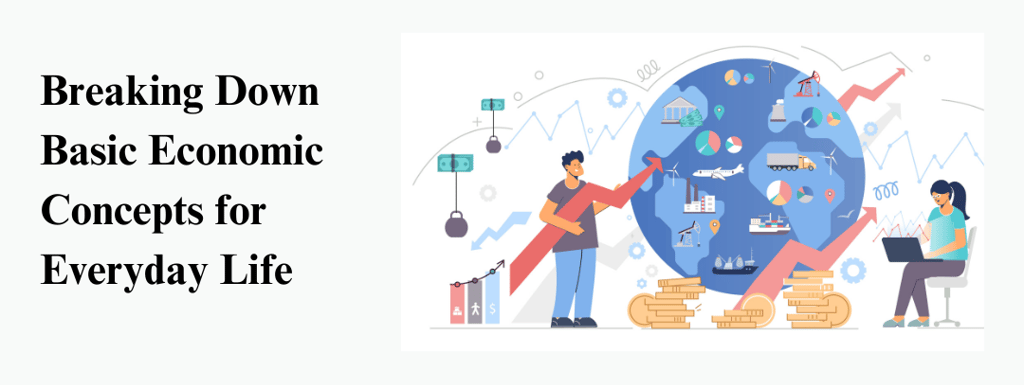Breaking Down Basic Economic Concepts for Everyday Life
"Understanding Basic Economics: Key Concepts Explained" simplifies essential topics like supply and demand, market equilibrium, and government roles for beginners.
BUSINESSNATIONAL


Understanding Supply and Demand: The Foundation of Market Behavior
Supply and demand are fundamental concepts in economics that govern the behavior of markets. At its core, supply and demand explain how the price and quantity of goods and services are determined. Understanding these concepts offers valuable insight into everyday economic phenomena.
The law of demand posits an inverse relationship between price and quantity demanded. Simply put, when the price of a good or service decreases, the quantity demanded increases, and vice versa. For example, if the price of apples falls, more consumers are likely to purchase them. This relationship is driven by consumer behavior and the principle of diminishing marginal utility, where each additional unit of a good provides progressively less satisfaction.
Conversely, the law of supply asserts a direct relationship between price and quantity supplied. As the price of a good or service rises, producers are more willing to supply more of it, anticipating higher revenues. For instance, if the price of wheat increases, farmers will be incentivized to grow more wheat to capitalize on the higher prices. This behavior is rooted in the desire to maximize profits.
Supply and demand interact to find an equilibrium price, the point at which the quantity demanded by consumers equals the quantity supplied by producers. This equilibrium can shift due to various factors. For example, an increase in consumer incomes can boost demand, leading to higher prices and quantities sold. On the other hand, technological advancements in production can increase supply, potentially lowering prices and increasing the quantity available in the market.
Real-life examples of supply and demand effects include the housing market, where prices often rise in cities with limited housing supply and high demand. Seasonal products also demonstrate these principles; for instance, the demand for ice cream surges in the summer, driving up both the quantity sold and potentially the prices.
Shifts in supply and demand curves have significant implications. A supply shock, such as a natural disaster affecting crops, can reduce supply and drive prices up. Similarly, a sudden increase in demand, such as during a holiday season, can lead to higher prices and shortages if supply cannot keep up.
The Role of Scarcity in Everyday Choices and Resource Allocation
Scarcity is a fundamental economic principle that underscores the reality that resources are limited while human wants are virtually unlimited. This imbalance between limited resources and insatiable desires creates a scenario where choices must be made about how these finite resources are utilized. Scarcity is not merely an abstract concept but one that permeates every facet of daily life, influencing decisions both on personal and societal levels.
To grasp the essence of scarcity, consider simple daily decisions such as how to spend time or money. For instance, an individual may have only 24 hours in a day but numerous activities they wish to engage in. The constraint on time necessitates prioritization, leading the individual to choose activities that provide the greatest value or satisfaction. Similarly, financial resources are often limited, requiring individuals to make decisions about how to allocate their money—whether to save, invest, or spend on immediate needs and wants.
Scarcity forces both individuals and societies to make trade-offs. A trade-off entails foregoing one option in favor of another, which is deemed more important or beneficial. For example, a student might decide to study for an exam instead of going out with friends, as the opportunity cost of potentially better grades outweighs the immediate gratification of socializing. On a macroeconomic level, governments face trade-offs when budgeting; allocating funds to healthcare may mean less investment in education or infrastructure.
Because resources such as time, money, and labor are limited, it becomes imperative to prioritize needs over wants. Needs are essential for survival—like food, shelter, and healthcare—whereas wants are additional desires that might enhance quality of life but aren’t crucial for survival. Efficient resource allocation aims to satisfy as many needs as possible before addressing wants, thereby maximizing overall well-being.
In conclusion, scarcity is an unavoidable aspect of economic life that influences how resources are allocated. Understanding and managing scarcity is crucial for making informed decisions that balance immediate desires with long-term benefits, maximizing both personal and societal welfare.
Budgeting Basics: Applying Economic Principles to Personal Finance
Budgeting serves as an essential tool for resource allocation, mirroring fundamental economic principles in a personal finance context. At its core, a budget helps individuals track income and expenses, allowing for effective financial management. By meticulously tracking their financial inflows and outflows, individuals can gain a clear understanding of their financial status.
Setting financial goals is paramount when formulating a budget. These objectives can range from short-term targets, such as saving for a vacation, to long-term ambitions, like purchasing a home. Clearly defined financial goals act as a roadmap, guiding one’s spending and saving decisions.
Distinguishing between fixed and variable expenses further refines budget planning. Fixed expenses, such as rent or mortgage payments, remain constant each month, while variable expenses, like groceries or entertainment, can fluctuate. Recognizing these distinctions allows for more precise allocation of resources, ensuring essential needs are prioritized while discretionary spending is adjusted as necessary.
The concept of opportunity cost plays a crucial role in budgeting. This economic principle entails evaluating what you sacrifice when allocating resources in a particular way. For instance, choosing to dine out frequently may mean sacrificing the opportunity to save for a future investment. Understanding opportunity costs aids in making informed financial decisions that align with one’s priorities.
Practical advice for creating a budget includes identifying all sources of income, listing and categorizing expenses, and regularly reviewing the budget to adjust for any changes in financial circumstances. Avoiding common financial pitfalls, such as accruing high-interest debt or neglecting emergency savings, is equally important. Implementing economic reasoning in financial decisions ensures that choices are made with long-term benefits in mind.
By integrating these economic concepts into personal finance practices, individuals can optimize their financial stability and achieve their financial goals. Utilizing a budget not only provides a structured approach to managing money but also fosters a deeper understanding of economic principles in everyday life.
